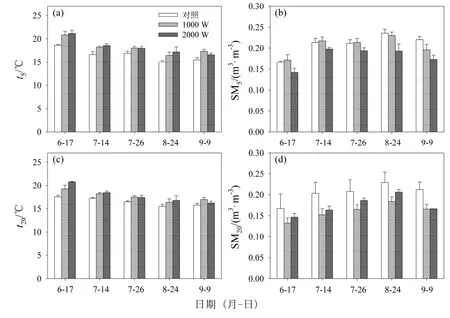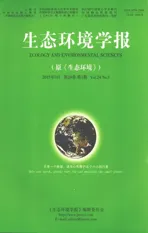西藏高原青稞三种植被指数对红外增温的初始响应
2015-12-06付刚沈振西钟志明
付刚,沈振西,钟志明
中国科学院地理科学与资源研究所 生态系统网络观测与模拟重点实验室 拉萨高原生态系统研究站,北京 100101
西藏高原青稞三种植被指数对红外增温的初始响应
付刚,沈振西,钟志明*
中国科学院地理科学与资源研究所 生态系统网络观测与模拟重点实验室 拉萨高原生态系统研究站,北京 100101
气候变暖影响着农作物生长及其植被指数。为了探讨西藏高原青稞(Hordeum vulgare Linn. var. nudum Hook.f.)归一化植被指数(normalized difference vegetation index,NDVI)、归一化绿波段差值植被指数(normalized green difference vegetation index,GNDVI)和土壤调节植被指数(soil adjusted vegetation index,SAVI)对气候变暖的初始响应,2014年5月在西藏达孜县布设了一个红外增温实验(3个水平,即对照,1 000和2 000 W红外增温)。通过对2014年6─9月利用农业多光谱相机获取的3种植被指数和利用HOBO微气候观测系统获取的两个深度(5和20 cm)的土壤温湿度的统计分析,探讨了西藏高原青稞植被指数对红外增温的响应及其与土壤温湿度的相互关系。结果表明,1 000和2 000 W的增温使5 cm的土壤温度(t5)分别升高了约1.62和1.77 ℃,使20 cm的土壤温度(t20)分别升高了约1.16和1.43 ℃;相反使5 cm的土壤湿度(SM5)分别下降了约1.8%和14.1%,使20 cm的土壤湿度(SM20)分别下降了21.6%和14.7%。1 000 W的增温使NDVI、GNDVI和SAVI分别增加了约2.4%、4.3%和0.5%;2 000 W的增温则使NDVI、GNDVI和SAVI分别增加了约5.5%、5.3%和4.8%,尽管增加幅度并不显著。单因子回归分析表明,t5与NDVI(r2=0.110,P=0.026)和GNDVI(r2=0.254,P=0.000 4)为负相关,而与SAVI无关(r2=0.069,P=0.082);t20与GNDVI为负相关(r2=0.218,P=0.001),而与NDVI(r2=0.040,P=0.190)和SAVI(r2=0.014,P=0.443)无关;SM5与NDVI(r2=0.277,P=0.000 2)、GNDVI(r2=0.394,P=0.000 0)和SAVI(r2=0.208,P=0.002)为正相关。SM20与GNDVI为正相关(r2=0.193,P=0.003),而与NDVI(r2=0.059,P=0.107)和SAVI(r2=0.037,P=0.209)无关。多重回归分析表明,SM5主导着NDVI、GNDVI和SAVI的变异。偏相关分析表明,NDVI、GNDVI和SAVI与SM5的相关系数分别为0.442(P=0.003)、0.412(P=0.007)和0.404(P=0.008);与SM20的相关系数分别为-0.042(P=0.792)、0.051(P=0.749)和-0.033(P=0.837);与 t5的相关系数分别为-0.154(P=0.332)、-0.019(P=0.907)和-0.170(P=0.282);与t20的相关系数分别为0.228(P=0.147)、-0.041(P=0.795)和0.268(P=0.086)。因此,红外增温引起的干旱抑制了青稞的生长,进而影响了植被指数,即植被指数的不显著变化可能与红外增温引起的土壤干旱有关。
青稞;归一化植被指数;归一化绿波段差值植被指数;土壤调节植被指数;红外增温
植被指数能够反映植被生长状态,常被用来反演植被生物量、植被盖度,植被物候、生态系统碳通量等(Boelman等,2003;Fu等,2013;Shen等,2011;Yi等,2011)。准确掌握植被指数对气候变暖的响应是准确预测气候变化背景下植被生长的前提条件(Piao等,2011;Shen等,2014)。目前,常见的植被指数有归一化植被指数(normalized difference vegetation index,NDVI)、增强型植被指数(enhanced vegetation index)、差值植被指数(difference vegetation index,DVI)、垂直植被指数(perpendicular vegetation index)、归一化绿波段差值植被指数(normalized green difference vegetation index,GNDVI)和土壤调节植被指数(soil adjusted vegetation index,SAVI)等(Gitelson等,1996;Huete,1988;Zhang等,2013a)。虽然在各种植被指数中,NDVI是应用最广泛的植被指数,但是NDVI仍存在一些难以克服的缺点,如在高密度植被区域容易出现饱和以及易受大气气溶胶和下垫面的干扰等(Piao等,2011;Shen等,2014;Zhang等,2013a)。与NDVI相比,GNDVI对植被叶绿素含量的变化更敏感(Gitelson等,1996);而SAVI则减少了土壤和植被冠层的干扰(Huete,1988)。因此,NDVI、GNDVI和SAVI在反映植被特征方面存在一定的差异,它们对气候变暖的敏感性可能不同。
因为植被指数反映的是植被生长状态,所以对植被生长有影响的环境因子都能够影响植被指数的变化。在高寒地区,低温往往是限制植物生长的最重要的环境因子之一,因此,温度升高一般会促进高寒植物的生长(Fu等,2015;Rustad等,2001)。尽管如此,温度升高带来的环境水分条件的变化也可能会限制高寒植物的生长(Fu等,2013)。最近的一些研究(Shen等,2014;Sun等,2013)表明,环境湿度条件而非环境温度主导着青藏高原高寒生态系统的植被指数的变异。因此,气候变暖是否一定会促进高寒植物的生长及其相关植被指数的增加还需要进一步的研究。
青藏高原是气候变化最敏感的区域之一(Fu等,2015;Zhang等,2015)。为了研究高寒生态系统对气候变暖的响应,在青藏高原上已经开展了一些相关的实验增温研究(Dorji等,2013;Shen等,2015;Yu等,2014)。尽管如此,这些实验增温主要集中在森林和草地生态系统,而缺少对农田生态系统的研究(Fu等,2015;Zhang等,2015)。基于遥感数据,虽然很多研究已经分析了青藏高原NDVI或EVI与气候因子的关系(Fu等,2013;Shen等,2014;Sun等,2013;Zhang等,2013b),但是很少有研究报道了GNDVI和SAVI与土壤温湿度的关系。此外,在青藏高原上,很少有研究报道了植被指数对实验增温的响应(Fu等,2013)。
青稞(Hordeum vulgare Linn. var. nudum Hook.f.)是青藏高原特有的主要农作物,具有耐寒、耐旱、耐瘠薄、生育期短、适应性强等优异种性,用于制作糌粑,酿制青稞酒等(Dai等,2012;Liu等,2013;Ren等,2013)。本研究以西藏自治区拉萨市达孜县农业生态试验站的栽培青稞为研究对象,利用红外增温的方式探讨了气候变暖背景下青稞3种植被指数(NDVI,GNDVI和SAVI)对实验增温的初始响应,以期明确气候变暖对西藏青稞生长及其相关植被指数的影响,从而为气候变化背景下西藏青稞的田间管理提供科学依据。本研究的主要目的有:(1)探讨植被指数的变异是否由环境湿度主导;(2)探讨3个植被指数对实验增温的响应是否存在差异。
1 材料与方法
1.1 研究地概况
研究地位于青藏高原腹地──西藏自治区拉萨市达孜县的中国科学院地理科学与资源研究所拉萨农业生态试验站进行,地理位置为东经91°20',北纬29°41'。海拔3688 m,属高原季风温带半干旱气候区。年平均气温为7.7 ℃,最热月7月平均气温16.3 ℃,最冷月12月平均气温为-1.5 ℃,无霜期120~130 d。年均降水量425 mm,90%以上分布在雨季的6月中旬─9月下旬。
1.2 实验设计
本研究采用红外辐射器(165 cm×15 cm,Kalglo Electronics Inc, Bethlehem, Pennsylvania)升高环境温度,辐射器距离地面高度约为1.7 m,增温水平为3个,即空白对照,1000和2000 W辐射增温,每个处理3个重复。增温样方大小为2 m×2 m,样方间隔约为6~7 m。
青稞于2014年5月26日播种,同时开始增温。行间距约为25 cm,播种量约为187.5 kg·hm-2。
利用HOBO微气候观测系统对5 cm的土壤温度(t5)、土壤湿度(SM5);20 cm的土壤温度(t20)和土壤湿度(SM20)进行了观测。
1.3 农业多光谱相机(ADC)及植被指数计算
ADC相机具有红、绿和近红外3个波段,分别与TM的第2、3和4波段相近(Fu等,2013)。本研究基于以下3个公式分别计算了NDVI、GNDVI和SAVI:

式中,redρ 、greenρ 和nirρ 分别表示ADC光谱相机红、绿和近红波段的反射率。
1.4 统计分析
采用重复测量方差分析对日均t5、SM5、t20和SM20,NDVI,GNDVI和SAVI进行了统计。通过相关分析、单因子回归分析和多重回归分析探讨了NDVI、GNDVI和SAVI与t5、SM5、t20和SM20的相互关系。
2 结果与分析
2.1 实验增温对土壤温湿度的影响
总体而言,红外增温对土壤温湿度无显著影响,而观测日期对土壤温湿度有显著影响;红外增温和观测日期的交互作用对t20有显著影响,对t5、SM5和SM20无显著影响(表1)。1000和2000 W的红外增温使t5分别升高了约1.62和1.77 ℃,使t20分别升高了约1.16和1.43 ℃;相反使SM5分别下降了约1.8%和14.1%,使SM20分别下降了21.6%和14.7%。

表1 西藏高原青稞红外增温样地5 cm土壤温度、5 cm的土壤湿度、20 cm的土壤温度和20 cm的土壤湿度的重复测量方差分析Table 1 Repeated measures analysis of variance for the main and interactive effects of infrared warming and measuring date on soil temperature at depth of 5 cm (t5), soil moisture at depth of 5 cm (SM5), soil temperature at depth of 20 cm (t20) and soil moisture at depth of 20 cm (SM20) in a highland barley in Tibet Plateau
土壤温度和土壤湿度都表现出了显著的时间变化(图1)。与对照相比,1000 W的红外增温使日均 t5和 t20分别升高了约 1.13~2.19 ℃和0.95~1.67 ℃(图1)。相反,1000 W的红外增温使日均SM20下降了约0.03~0.05 m3·m-3,同时使8月24日和9月9日的日均SM5分别下降了0.01和0.02 m3·m-3(图1)。此外,1000 W的红外增温使6月17日、7月14日和7月26日的日均SM5分别增加了约0.01、0.004和0.002 m3·m-3(图1)。与对照相比,2000 W的红外增温使日均t5和t20分别升高了约1.09~2.51 ℃和0.51~3.21 ℃(图1)。相反,2000 W 的红外增温使日均 SM5和 SM20分别下降了约0.016~0.047 m3·m-3和0.020~0.046 m3·m-3(图1)。

图1 红外增温对西藏高原青稞5 cm土壤温度、5 cm土壤湿度、20 cm土壤温度和20 cm土壤湿度的影响(n=3)Fig. 1 Effects of infrared warming on soil temperature at depth of 5 cm (T5), soil moisture at depth of 5 cm (SM5), soil temperature at depth of 20 cm (T20) and soil moisture at depth of 20 cm (SM20) in a highland barley in Tibet Plateau(n=3)
2.2 实验增温对NDVI、GNDVI和SAVI的影响
总体而言,红外增温及其与观测日期的交互作用对NDVI、GNDVI和SAVI无显著影响,而观测日期对NDVI、GNDVI和SAVI都有显著影响(表2)。

表2 西藏高原青稞红外增温样地归一化植被指数、归一化绿波段差值植被指数和土壤调节植被指数的重复测量方差分析Table 2 Repeated measures analysis of variance for the main and interactive effects of infrared warming and measuring date on normalized difference vegetation index(NDVI), green normalized difference vegetation index (GNDVI) and soil adjusted vegetation index (SAVI) in a highland barley in Tibet Plateau
1000 W 的红外增温使 NDVI、GNDVI和SAVI分别增加了约2.4%(0.013)、4.3%(0.009)和0.5%(0.002)。而2000 W的红外增温则使NDVI、GNDVI和SAVI分别增加了约5.5%(0.029)、5.3%(0.011)和4.8%(0.020)。
NDVI、GNDVI和SAVI都表现出了显著的时间变化(图2)。1000 W的红外增温使6月17日、7月26日和8月24日的NDVI分别增加了0.048、0.004和0.065,2000 W的红外增温使6月17日、7月26日、8月24日和9月9日的NDVI分别增加了约0.076、0.028、0.034和0.116。1000 W的红外增温使6月17日、7月14日、7月26日和8月24日的GNDVI分别增加了约0.026、0.005、0.010和0.027。2000 W的红外增温则使6月17日、7月26日、8月24日和9月9日的GNDVI分别增加了约0.031、0.010、0.018和0.025。1000 W的红外增温使6月17日和8月24日的SAVI分别增加了约0.024和0.059。2000 W的红外增温则使6月17日、7月26日、8月24日和9月9日的SAVI分别增加了约0.070、0.011、0.024和0.103。相反,1000 W的红外增温使7月14日和9月9日的NDVI分别减少了约0.010和0.044;9月9日的GNDVI减少了约0.024;7月14日、7月26日和9月9日的SAVI减少了约0.015、0.014和0.044。2000 W的红外增温则使7月14日的NDVI、GNDVI和SAVI分别减少了约0.107、0.031和0.110。

图2 红外增温对西藏高原青稞归一化植被指数、归一化绿波段差值植被指数和土壤调节植被指数的影响(n=3)Fig. 2 Effects of infrared warming on normalized difference vegetation index(NDVI), green normalized difference vegetation index (GNDVI) and soil adjusted vegetation index (SAVI) in a highland barley in Tibet Plateau (n=3)
2.3 植被指数与土壤温湿度的关系
单因子回归分析表明,NDVI(r2=0.110,P=0.026)和 GNDVI(r2=0.254,P=0.0004)随着t5的增加而降低,但是 SAVI下降趋势不显著(r2=0.069,P=0.082);GNDVI随着t20的增加而降低(r2=0.218,P=0.001),但是 NDVI(r2=0.040,P=0.190)和SAVI(r2=0.014,P=0.443)的下降趋势不显著。相反,NDVI(r2=0.277,P=0.0002)、GNDVI(r2=0.394,P=0.0000)和SAVI(r2=0.208,P=0.002)都随着 SM5的增加而增加;GNDVI随着SM20的增加而增加(r2=0.193,P=0.003),NDVI(r2=0.059,P=0.107)和SAVI(r2=0.037,P=0.209)的增加趋势不显著(图3)。
多重回归分析表明,SM5解释了 NDVI、GNDVI和SAVI的变异,即SM5主导着3个植被指数的变异。
偏相关分析表明,当 t5、t20和 SM20作为控制变量时,NDVI、GNDVI和SAVI与SM5的相关系数分别为0.442(P=0.003)、0.412(P=0.007)和0.404(P=0.008);当t5、t20和SM5作为控制变量时,NDVI、GNDVI和SAVI与SM20的相关系数分别为-0.042(P=0.792)、0.051(P=0.749)和-0.033(P=0.837);当t20、SM5和SM20作为控制变量时,NDVI、GNDVI和SAVI与t5的相关系数分别为-0.154(P=0.332)、-0.019(P=0.907)和-0.170(P=0.282);当t5、SM5和SM20作为控制变量时,NDVI、GNDVI和SAVI与 t20的相关系数分别为 0.228(P=0.147)、-0.041(P=0.795)和0.268(P=0.086)。
3 讨论
红外增温形成的暖干化环境与前人的研究一致(Bai等,2013;Rui等,2011;Yin等,2013)。如Wang等(2012)在海北高寒草甸的研究表明,红外增温增加了土壤温度的同时减少了土壤湿度。Shen等(2014)的研究表明,在过去的十多年间(2000─2012),青藏高原总体上及其农田生态系统都呈暖干化趋势。Zhang等(2013b)的研究则表明,在过去的10年间(2000─2009),西藏高原总体上为暖干化气候变化趋势。Fu等(2013)的研究也表明,在 2000─2012年间,西藏高原总体上为暖干化趋势。

图3 归一化植被指数、归一化绿波段差值植被指数和土壤调节植被指数与5 cm土壤温度、5 cm土壤湿度、20 cm土壤温度和20 cm土壤湿度的关系Fig. 3 Relationships between normalized difference vegetation index (NDVI), green normalized difference vegetation index (GNDVI) and soil adjusted vegetation index (SAVI) and soil temperature at depth of 5 cm (T5), soil moisture at depth of 5 cm (SM5), soil temperature at depth of 20 cm (T2o) and soil moisture at depth of 20 cm (SM20) in a highland barley in Tibet Plateau
红外增温没有显著影响 NDVI、GNDVI和SAVI,这表明短期的红外增温对这3个植被指数的影响无差别。前人对青藏高原植被指数变化与气候变化的相关研究也表明植被指数对气候变化的响应不显著。如Sun等(2013)对青藏高原最大NDVI的研究表明,1982─2006年间,最大NDVI增加趋势不显著。Shen等(2014)对青藏高原生长季节最大EVI的研究表明,2000─2012年间最大EVI的降低趋势不显著。Fu等(2013)对西藏高原高寒草甸的研究表明,2000─2012年间,生长季节平均的NDVI的增加趋势不显著。Hu等(2011)对三江源区的研究表明,1982─2000年间,最大NDVI的变化不显著。赵芳等(2011)同样发现2000─2009年间三江源区NDVI和EVI无显著变化。
NDVI、GNDVI和SAVI与土壤温湿度的相互关系与前人的研究结果一致。如 Shen等(2014)的研究表明,青藏高原农田生态系统的最大EVI与空气温度为不显著的负相关,而与相对湿度和水汽压为显著正相关,与饱和水汽压为显著负相关;总体而言,青藏高原空间平均的最大EVI与空气温度为不显著负相关,而与相对湿度和水汽压为显著正相关。Fu等(2013)的研究表明,总初级生产力和地上生物量与空气温度为负相关,与土壤湿度为正相关。
土壤湿度对NDVI、GNDVI和SAVI的影响大于土壤温度的影响,这与前人的研究结果一致。如Shen等(2014)的研究表明,空气湿度主导着青藏高原最大EVI的空间变异。Sun等(2013)的研究表明,降水对青藏高原最大NDVI的影响大于空气温度的影响。Xu等(2008)的研究表明,青藏高原植被盖度的变异主要受降水调控。周睿等(2007)的研究指出,青藏高原生长季节平均的EVI随着年均降水量的增加显著增加,但与年均温无关。赵芳等(2011)也指出三江源区域的NDVI和EVI与降水的相关性大于与空气温度的相关性。
多重回归分析和偏相关分析都表明,土壤湿度而非土壤温度主导着NDVI、GNDVI和SAVI的变异,且这3个植被指数都随着土壤湿度的增加而显著增加。此外,实验增温降低了土壤湿度,而土壤干旱会抑制植物的生长(Carrara等,2004;Fu等,2013),进而影响植被指数。因此,NDVI、GNDVI和SAVI对红外增温的不显著初始响应可能主要是由实验增温引起的土壤干旱引起的。
4 结论
与土壤温度相比,土壤湿度主导着归一化植被指数、归一化绿波段差值植被指数和土壤调节植被指数的变异,且这3个植被指数都随着土壤湿度的增加而显著增加。3个植被指数对红外增温的短期响应都没有显著变化,这可能与红外增温引起的土壤干旱有关。
BAI E, LI S L, XU W H, et al. 2013. A meta-analysis of experimental warming effects on terrestrial nitrogen pools and dynamics[J]. New Phytologist, 199(2): 441-451.
BOELMAN N T, STIEGLITZ M, RUETH H M, et al. 2003. Response of NDVI, biomass, and ecosystem gas exchange to long-term warming and fertilization in wet sedge tundra[J]. Oecologia, 135(3): 414-421.
CARRARA A, JANSSENS I A, YUSTE J C, et al. 2004. Seasonal changes in photosynthesis, respiration and NEE of a mixed temperate forest[J]. Agricultural and Forest Meteorology, 126(1-2): 15-31.
DAI F, NEVO E, WU D Z, et al. 2012. Tibet is one of the centers of domestication of cultivated barley[J]. Proceedings of the National Academy of Sciences of the United States of America, 109(42): 16969-16973.
DORJI T, TOTLAND O, MOE S R, et al. 2013. Plant functional traits mediate reproductive phenology and success in response to experimental warming and snow addition in Tibet[J]. Global Change Biology, 19(2): 459-472.
FU G, SHEN Z X, SUN W, et al. 2015. A meta-analysis of the effects of experimental warming on plant physiology and growth on the Tibetan Plateau[J]. Journal of Plant Growth Regulation, 34(1): 57-65.
FU G, ZHANG X, ZHANG Y, et al. 2013. Experimental warming does not enhance gross primary production and above-ground biomass in the alpine meadow of Tibet[J]. Journal of Applied Remote Sensing, 7(1): doi: 10.1117/1.jrs.7.073505.
GITELSON A A, KAUFMAN Y J, MERZLYAK M N. 1996. Use of a green channel in remote sensing of global vegetation from EOS-MODIS[J]. Remote Sensing of Environment, 58(3): 289-298.
HU M Q, MAO F, SUN H, et al. 2011. Study of normalized difference vegetation index variation and its correlation with climate factors in the three-river-source region[J]. International Journal of Applied Earth Observation and Geoinformation, 13(1): 24-33.
HUETE A R. 1988. A soil-adjusted vegetation index (SAVI)[J]. Remote Sensing of Environment, 25(3): 295-309.
LIU Z F, YAO Z J, YU C Q, et al. 2013. Assessing crop water demand and deficit for the growth of spring highland barley in Tibet, China[J]. Journal of Integrative Agriculture, 12(3): 541-551.
PIAO S, CUI M, CHEN A, et al. 2011. Altitude and temperature dependence of change in the spring vegetation green-up date from 1982 to 2006 in the Qinghai-Xizang Plateau[J]. Agricultural and Forest Meteorology, 151(12): 1599-1608.
REN X F, NEVO E, SUN D F, et al. 2013. Tibet as a potential domestication center of cultivated barley of China[J]. PLoS ONE, 8(5): doi: 10.1371/journal.pone.0062700.
RUI Y C, WANG S P, XU Z H, et al. 2011. Warming and grazing affect soil labile carbon and nitrogen pools differently in an alpine meadow of the Qinghai-Tibet Plateau in China[J]. Journal of Soils and Sediments, 11(6): 903-914.
RUSTAD L E, CAMPBELL J L, MARION G M, et al. 2001. A meta-analysis of the response of soil respiration, net nitrogen mineralization, and aboveground plant growth to experimental ecosystem warming[J]. Oecologia, 126(4): 543-562.
SHEN M G, TANG Y H, CHEN J, et al. 2011. Influences of temperature and precipitation before the growing season on spring phenology in grasslands of the central and eastern Qinghai-Tibetan Plateau[J]. Agricultural and Forest Meteorology, 151(12): 1711-1722.
SHEN Z, FU G, YU C, et al. 2014. Relationship between the growing season maximum enhanced vegetation index and climatic factors on the Tibetan Plateau[J]. Remote Sensing, 6(8): 6765-6789.
SHEN Z X, LI Y L, FU G. 2015. Response of soil respiration to short-term experimental warming and precipitation pulses over the growing season in an alpine meadow on the Northern Tibet[J]. Applied Soil Ecology, 90: 35-40.
SUN J, CHENG G W, LI W P, et al. 2013. On the variation of NDVI with the principal climatic elements in the Tibetan Plateau[J]. Remote Sensing, 5(4): 1894-1911.
WANG S P, DUAN J C, XU G P, et al. 2012. Effects of warming and grazing on soil N availability, species composition, and ANPP in an alpine meadow[J]. Ecology, 93(11): 2365-2376.
XU X K, CHEN H, LEVY J K. 2008. Spatiotemporal vegetation cover variations in the Qinghai-Tibet Plateau under global climate change[J]. Chinese Science Bulletin, 53(6): 915-922.
YI S H, ZHOU Z Y, REN S L, et al. 2011. Effects of permafrost degradation on alpine grassland in a semi-arid basin on the Qinghai-Tibetan Plateau[J]. Environmental Research Letters, 6(4): doi: 10.1088/1748-9326/6/4/045403.
YIN H J, LI Y F, XIAO J, et al. 2013. Enhanced root exudation stimulates soil nitrogen transformations in a subalpine coniferous forest under experimental warming[J]. Global Change Biology, 19(7): 2158-2167.
YU C Q, SHEN Z X, ZHANG X Z, et al. 2014. Response of soil C and N, dissolved organic C and N, and inorganic N to short-term experimental warming in an Alpine meadow on the Tibetan Plateau[J]. Scientific World Journal, doi: 10.1155/2014/152576.
ZHANG G L, ZHANG Y J, DONG J W, et al. 2013a. Green-up dates in the Tibetan Plateau have continuously advanced from 1982 to 2011[J]. Proceedings of the National Academy of Sciences of the United States of America, 110(11): 4309-4314.
ZHANG L, GUO H D, JI L, et al. 2013b. Vegetation greenness trend (2000 to 2009) and the climate controls in the Qinghai-Tibetan Plateau[J]. Journal of Applied Remote Sensing, 7(1): doi: 10.1117/1.jrs.7.073572.
ZHANG X Z, SHEN Z X, FU G. 2015. A meta-analysis of the effects of experimental warming on soil carbon and nitrogen dynamics on the Tibetan Plateau[J]. Applied Soil Ecology, 87: 32-38.
赵芳, 林恭华, 赵之重. 2011. 三江源区植被指数时空变化对水热条件的响应[J]. 草业科学, 28(6): 1095-1100.
周睿, 杨元合, 方精云. 2007. 青藏高原植被活动对降水变化的响应[J].北京大学学报: 自然科学版, 43(6): 771-775.
Initial Response of Normalized Difference Vegetation Index, Green Normalized Difference Vegetation Index and Soil Adjusted Vegetation Index to Infrared Warming in Highland Barley of the Tibet
FU Gang, SHEN ZhenXi, ZHONG ZhiMing
Lhasa Plateau Ecosystem Research Station, Key Laboratory of Ecosystem Network Observation and Modeling, Institute of Geographic Sciences and Natural Resources Research, Chinese Academy of Sciences, Beijing 100101, China
Climatic warming affects the crop growth and its related vegetation indices. In order to understand the initial response of normalized difference vegetation index (NDVI), normalized green difference vegetation index (GNDVI) and soil adjusted vegetation index (SAVI) to climatic warming, a field warming experiment using infrared radiator was conducted in a highland barley located at the Dazi county of the Tibet since late May, 2015. There were three warming treatments, i.e., control, low (1000 W) and high (2000W) warming. The NDVI, GNDVI and SAVI were obtained using an agricultural digital camera during the period from June to September in 2015. Meanwhile, the soil temperature and soil moisture at depths of 5 cm and 20 cm were also obtained using HOBO microclimate observing systems. Then this study analyzed the response of NDVI, GNDVI and SAVI to infrared warming and the relationships between the three vegetation indices and soil temperature and moisture. The 1000 W and 2000 W infrared warming increased soil temperature at the depth of 5 cm (t5) by 1.62 ℃ and 1.77 ℃, and soil temperature at the depth of 20 cm (t20) by 1.16 ℃ and 1.43 ℃, but decreased soil moisture at the depth of 5 cm (SM5) by 1.8% and 14.1%, and soil moisture at the depth of 20 cm (SM20) by 21.6% and 14.7%, respectively. The 1000 W infrared warming increased NDVI by 2.4%, GNDVI by 4.3% and SAVI by 0.5%, whereas the 2000 W infrared warming increased NDVI by 5.5%, GNDVI by 5.3% and SAVI by 4.8%, although these changes were non-significant. Simple regression analyses showed that (1) NDVI (r2=0.110, P=0.026) and GNDVI(r2=0.254, P=0.000 4)decreased with increasing t5,whereas there was non-significant correlation between SAVI and t5(r2=0.069, P=0.082); (2) GNDVI decreased with increasing t20, (r2=0.218, P=0.001), whereas there were non-significant relationships between NDVI (r2=0.040, P=0.190), SAVI (r2=0.014, P=0.443) and t20; (3) NDVI (r2=0.277, P=0.000 2), GNDVI (r2=0.394, P=0.000 0) and SAVI (r2=0.208, P=0.002)increased with increasing SM5; and (4) GNDVI increased with increasing SM20(r2=0.193, P=0.003), whereas there were non-significant correlations between NDVI (r2=0.059, P=0.107), SAVI (r2=0.037, P=0.209) and SM20. Multiple regression analyses indicated that SM5dominated the variations of NDVI, GNDVI and SAVI. Partial correlation analyses demonstrated that (1) the correlation coefficients of NDVI, GNDVI and SAVI with SM5were 0.442 (P=0.003), 0.412 (P=0.007) and 0.404 (P=0.008); (2) with SM20were -0.042 (P=0.792), 0.051 (P=0.749) and -0.033 (P=0.837); (3) with t5were -0.154 (P=0.332), -0.019 (P=0.907) and -0.170 (P=0.282); and (4) with t20were 0.228 (P=0.147), -0.041 (P=0.795) and 0.268 (P=0.086), respectively. Therefore, the soil drying induced by infrared warming suppressed the growth of highland barley, which in turn affected vegetation indices. That is, the non-significant changes of the three vegetation indices may be due to the infrared warming-induced drying.
highland barley; normalized difference vegetation index; green normalized difference vegetation index; soil adjusted vegetation index; infrared warming
10.16258/j.cnki.1674-5906.2015.03.001
Q948
A
1674-5906(2015)03-0365-07
付刚,沈振西,钟志明. 西藏高原青稞三种植被指数对红外增温的初始响应[J]. 生态环境学报, 2015, 24(3): 365-371. FU Gang, SHEN Zhenxi, ZHONG Zhiming. Initial Response of Normalized Difference Vegetation Index, Green Normalized Difference Vegetation Index and Soil Adjusted Vegetation Index to Infrared Warming in Highland Barley of the Tibet [J]. Ecology and Environmental Sciences, 2015, 24(3): 365-371.
国家自然科学基金项目(31370458);国家科技支撑项目(2011BAC09B03)
付刚(1984年生),男,助理研究员,博士,研究方向为全球变化与高寒生态系统。E-mail: fugang@igsnrr.ac.cn *通信作者:钟志明(1971年生),男,助理研究员,研究方向为高寒农田生态系统与全球变化。E-mail: zhongzm@igsnrr.ac.cn
2014-11-06
